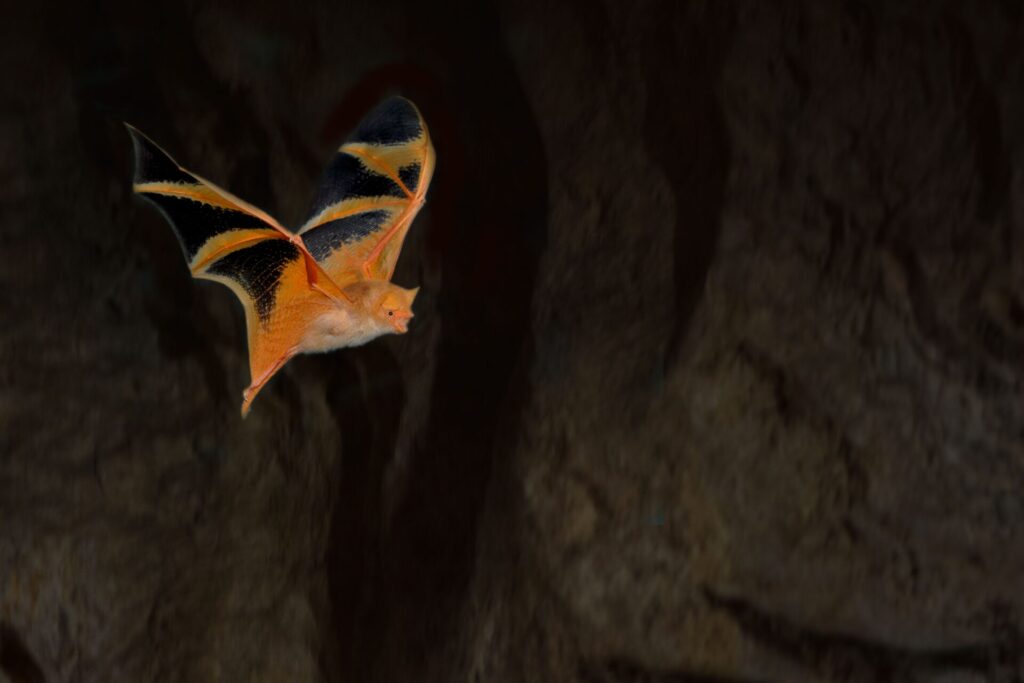A flash of orange and black in the canopy has marked a major conservation milestone in India’s Western Ghats with the first ever sighting of a Painted Bat (Kerivoula picta) in the Ratnagiri district.
The bat was spotted in a sacred grove protected by our conservation partner Applied Environmental Research Foundation (AERF). Its presence here speaks volumes to the work performed by AERF, with over five years of careful ecological restoration of this nine-hectare (23-acre) site.
At WLT, we are delighted by this news, which also underscores the contribution of our supporters, who have been helping fund ecological restoration and the creation of corridors between sacred groves here since 2018.
The protection of old growth forests like these benefits a whole range of species. Since 2018, WLT have been improving ecological connectivity between these sites. Credit: Richard Cuthbert/WLT
A tiny bat with an interesting story
The Painted Bat is not a big animal. From the tip of its nose to the tip of its tail, it measures in at no more than 11 cm or half the size of a Field Mouse (Apodemus sylvaticus). At this size, it could fit quite comfortably in the palm of your hand, if it weren’t for those wings – up to 30 cm across and coal black shot through with electric lines of orange.
It has quite a few local names, unsurprisingly for so distinctive an animal. The most colourful of these is butterfly bat, a direct translation from the Bengali projapoti badur. In other ways, it is similar to its relatives in the Kerivoula genus: possessing long, curly hair, a small, fragile form, large funnel-shaped ears and 38 rather sharp teeth.
The reason for its startling colouration is thought to be linked to its unusual choice of roosting site. Rather than dark, damp caves, the Painted Bat favours cosier homes, opting for banana tree leaves, weaver finch nests, and the eaves of village huts. During the day, the bat snuggles down in these and becomes sluggish, entering a kind of lethargic torpor. This is a vulnerable time for the Painted Bat. And so its black and orange colours may actually be a form of camouflage, allowing it to blend in with dried leaves and flowers when they roost.
At night, the Painted Bat is far from docile and fluffy however, becoming an adept insect hunter – known within the bat world as an “aerial hawker”. It owes its success to fine-tuned echolocation, enabling it to hone in on unsuspecting insects. Interestingly, those bats that make higher-pitched calls are better able to navigate cluttered, leafy spaces.
Why this sighting matters
The Painted Bat is currently listed as Near Threatened, and because it raises just one pup a year, its populations are slow to recover from habitat disturbance. Sacred groves in the Western Ghats act as vital refuges of biodiversity – pockets of old, complex forest amid a landscape under ever increasing pressure.
The sighting in Ratnagiri shows two important things:
- Forest restoration works. When degraded groves are restored, wildlife can return.
- Protection today prevents crisis tomorrow. Conserving forests now helps ensure that species like the Painted Bat do not become Endangered in the future.
This discovery is the result of years of dedicated protection by AERF’s field team and community forest stewards – together with the unwavering commitment of WLT supporters.
Act now to create more stories like this.

